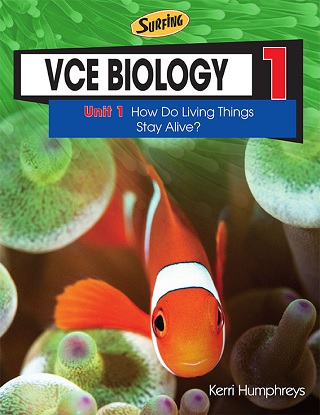VCE Surfing Biology Unit 1
- Kerri Humphreys
- Science Press
- 2016
- ISBN: 9780855837570
RRP: $49.95 (Inc. GST)

Description
This book covers the Biology content specified in the Victorian Certificate of Education Biology Study Design. Sample data has been included for suggested experiments to give you practice to reinforce practical work in class.
Each book in the Surfing series contains a summary, with occasional more detailed sections, of all the mandatory parts of the syllabus, along with questions and answers.
All types of questions – multiple choice, short response, structured response and free response – are provided.
Questions are written in exam style so that you will become familiar with the concepts of the topic and answering questions in the required way.
Answers to all questions are included.
A topic test at the end of the book contains an extensive set of summary questions. These cover every aspect of the topic, and are useful for revision and exam practice.
Table of Contents
Introduction
Words to Watch
Area of Study 1 How Do Organisms Function?
1 Assumed Knowledge
2 Characteristics of Living Things
3 Developing the Cell Theory
4 Cell Theory and Robert Hooke
5 Cell Theory and Robert Brown
6 Technology and the Development of the Cell Theory
7 The Modern Light Microscope
8 The Electron Microscope
9 The Stereo Microscope
10 Experiment – The Light Microscope
11 Experiment – Using a Light Microscope
12 Experiment – Making a Wet Mount
13 Experiment – Drawing Biological Diagrams
14 Writing a Practical Report
15 Prokaryotes
16 Eukaryotes
17 Experiment – Plant Cells
18 Experiment – Animal Cells
19 Experiment – Surface Area to Volume Ratio
20 Experiment – Surface Area and Rate of Reaction
21 The Light Microscope and Cell Organelles
22 The Electron Microscope and Cell Organelles
23 Mitochondria
24 Chloroplasts
25 Golgi Bodies
26 Cell Organelles Summary
27 Development of the Model of the Plasma Membrane
28 The Current Plasma Membrane Model
29 Passive Transport
30 Diffusion and Osmosis
31 Active Transport
32 Experiment – Membranes, Diffusion and Osmosis
33 Experiment – Plasmolysis
34 Experiment – Material Exchange and Concentration Gradient
35 Material Exchange and the Nature of the Material
36 Chemicals in Cells
37 Experiment – Substances in Tissues
38 Cell Input and Output
39 Autotrophs and Heterotrophs
40 Photosynthesis
41 Play – Inside Photosynthesis
42 Photosynthesis and Productivity
43 Aerobic Respiration
44 Anaerobic Respiration
45 Cells, Tissues, Organs and Systems
46 Plant Tissues and Cells
47 Plant Organs
48 Root Structure
49 Leaves
50 Stomates
51 Experiment – Transpiration
52 Transport Systems in Plants
53 Experiment – Movement in Xylem
54 Radioisotopes Track the Movement of Substances in Organisms
55 Acacia in Australia
56 Differentiation and Specialised Cells
57 Human Organ Systems
58 Organ and Tissue Transplantation
59 Bioartificial Organs
60 The Digestive System
61 Teeth
62 Specialised Digestive Systems
63 Play – Amino and Lipidet, A Most Lamentable Tragedy
64 Respiratory Systems
65 Gas Exchange, Breathing and Ventilation
66 Circulatory Systems in Animals
67 Excretion, Respiration and Water
68 Excretory Organs
69 The Kidney
70 Renal Hormones
71 Renal Dialysis
72 Chemical Monitoring
73 Experiment – Carbon Dioxide and pH
74 CAT and MRI Scans
Area of Study 2 How Do Living Things Sustain Life?
75 Adaptations
76 Adaptations in Plants
77 Adaptations in Invertebrates
78 Adaptations in Vertebrates
79 The Platypus
80 Animal Ethics
81 Biomimicry
82 Homeostasis
83 The Role of the Nervous System
84 The Stimulus-Response Model
85 Reflexes
86 Receptors
87 Feedback Mechanisms
88 Homeostasis and Temperature Control
89 Modelling Human Thermoregulation
90 Homeostasis and Blood Composition
91 Changing Metabolic Activity
92 The Hypothalamus and Homeostasis
93 Body Structures Aid Homeostasis
94 Behaviour and Homeostasis
95 Homeostasis, Excretion and Osmoregulation
96 Osmoreceptors and Water Balance
97 The Thyroid Gland
98 The Pancreas
99 Classification
100 Different Classification Systems
101 Features Used in Animal Classification
102 Classifying Extinct Organisms
103 A Dichotomous Key For Plants
104 A Dichotomous Key for Animals
105 Biodiversity – Genetic Diversity
106 Biodiversity – Species Diversity
107 Insect Diversity
108 Moth Diversity
109 Biodiversity – Ecosystem Diversity
110 Present Australian Biomes
111 International Agreements, Biology and Biodiversity
112 Biodiversity and Sustainable Development
113 Biodiversity Targets
114 Indigenous Knowledge of Ecosystems
115 Marine Reserves
116 Supercomputers and Biology
117 Amensalism and Competition
118 Allelopathy
119 Commensalism
120 Mutualism
121 Parasitism
122 Predator-Prey Populations
123 Food Chains and Food Webs
124 Play – Inside a Food Web
125 Practice with Food Webs
126 Field Study – A Food Web in a Rock Pool
127 Keystone Species and Conservation
128 Population Ecology
129 Trends in Population Estimates
130 Distribution and Abundance
131 The Changing Distribution of Australian Species
132 Distribution and Climate
133 Distribution Variations
134 Sampling Techniques – Transects
135 Field Study – Transects
136 Sampling Techniques – Quadrats
137 Activity – A Quadrat Study
138 Field Study – Abundance Using Random Quadrats
139 Sampling Techniques – Percentage Cover
140 Field Study – Percentage Cover
141 Sampling Animal Populations
142 Experiment – Capture-Mark-Recapture
143 Abiotic and Biotic Features of the Environment
144 Abiotic Features of Aquatic Environments
145 Australia and Abiotic Environments
146 Field Study – Abiotic Features
147 Habitats
148 Ecological Niches
149 Disease
150 Ecosystem Modelling
Topic Test
Answers
Index

![Nature of Biology: 1 - VCE Units 1 & 2 [Text + LearnON + Free StudyON]](https://endeavoureducation.com.au/wp-content/uploads/2020/07/9780730388050.png)

![Cambridge VCE Biology Units 1&2 [Interactive CambridgeGO Only]](https://endeavoureducation.com.au/wp-content/uploads/2020/07/9781108894609.png)
